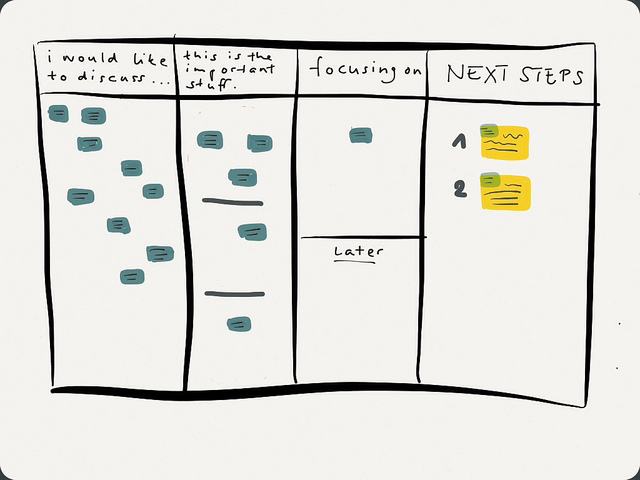This is the 4th post in a guest series, Kanban: A Universe of Options for Life's Planning & Organizing Challenges by Nadja Schnetzler.
Here are a few kanban boards that were created in trainings with individuals and teams:
See the neat illustrations using fish?
This participant visualized everything with street symbols
A participant explaining his solution out of 10 different kanban boards
Using kanban boards in very different contexts
I have used kanban boards in many shapes and forms for the most different situations over the last years. It’s amazing how adaptable the concept is. Here are a few examples of kanban boards I have created, used, encountered and encouraged.
The Cleaning Party kanban board
In our family, we have a ritual on Saturdays called „the cleaning party“. It means that we gather as a family (2 adults and 2 young teens) collect all the tasks that come to our minds related to our household, and then work for two hours on those tasks. We have used a kanban board for this activity now for three years, and the fact that everyone can pull the tasks that work best for him or her is great. We have also introduced the role of the facilitator. This person has an overview, calls for breaks, gives out little treats during the cleaning party and makes sure we debrief when the party comes to a close.
The family conference kanban board
For our “family conference”, a weekly meeting where we discuss important family matters and issues, we also have created a kanban board. It is used as a discussion board to organize the discussion topics and to see what we are focusing on in the discussion right now. Everyone can contribute discussion topics on postits, and then, in turn, each family member picks a postit and this item is discussed. Whatever we decide during our discussion is noted on a bigger stickie and then pulled into the "decided" column. I really love the way this system helps my children to focus on a topic, to use tactics in picking topics and in respecting the other family members.
The coaching meeting kanban board
When I meet people for personal coaching, mainly people who are in some kind of change process, I also use a kanban board to work with them. A board helps to collect the possible discussion topics (based on some questions I ask the participant during our first few minutes of the meeting). Then, it's time to decide which of the collected topics should first be discussed. This means pulling the stickies from the first column into the second. I use three layers in the second column to show that again, the postits can be prioritized further.
Then we decide which topic we should discuss first. This one wanders into the "focus" column. Sometimes, when discussing an issue we realize that to really discuss it we need additional information, in which case the postit goes to the "later" section. And finally, when we feel we have discussed a topic at length, we put it into the "Next Steps" column, where we later formulate a plan of what to do now based on all the discussed items.
The beautiful thing of a coaching kanban board is that we can just continue where we left in the next meeting, and we have all the information at hand.
The portable kanban board
I have a portable version of my kanban board because I travel a lot. It's a large paper with my usuall columns, folded down to a portable size, and reinforced with tape, When I travel, I take the stickies from my board at home and stick them onto my portable board. When I come home, I "synchronize" the boards. It's super easy. I use small size stickies on all my boards so that they also fit my transportable version.
My portable kanban board
Nadja Schnetzler was born in Switzerland and spent her childhood in Mexico City. After graduating from High School, she was a founding member of BrainStore, the first Idea Factory in the world. She has a bachelors degree in journalism from renowned “Ringier School of Journalism”. Over the last 25 years, Nadja has led over 600 innovation projects for companies like Nestlé, Siemens, the Swiss Railways, Kraft Foods, BMW, Save the Children, the United Nations or Amnesty International. She is the author of the book “The Ideamachine” (Wiley) and a sought-after speaker and lecturer at various universities.In 2012, Nadja founded «Word and Deed» with the aim at inspiring organisations, companies, teams and individuals. Word and Deed works in the areas of communication, innovation and collaboration. Kanban has become one of the most important agents of change for Nadja and her clients.Nadja lives in Switzerland with her husband and her two teenage kids. She enjoys listening to and playing baroque music (with her violin) and has an open house for people from all walks of life.This is the 4th post in the guest series by Nadja Schnetzler – Kanban: A Universe of Options for Life’s Planning & Organizing Challenges. You can read the previous post here.







